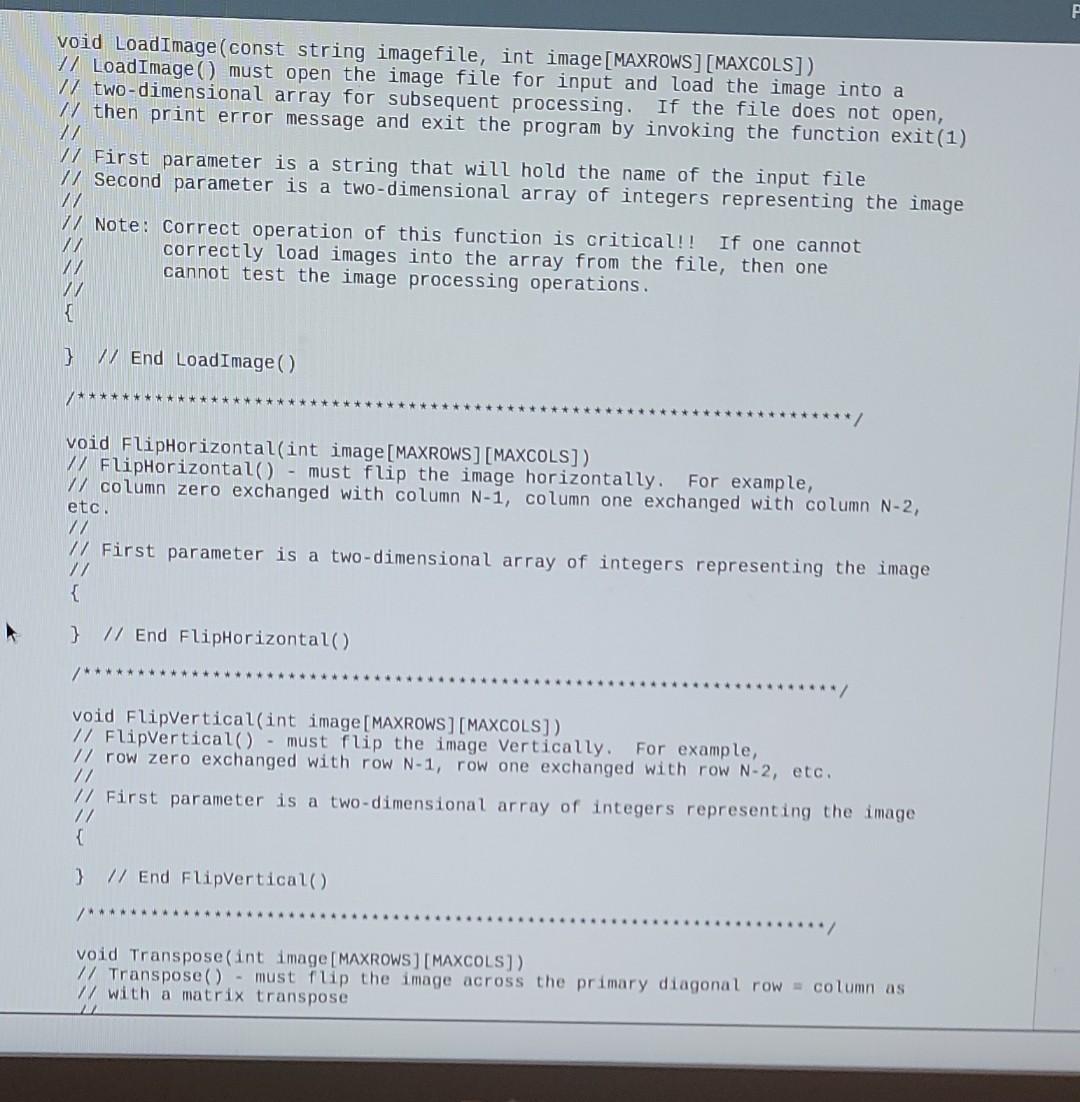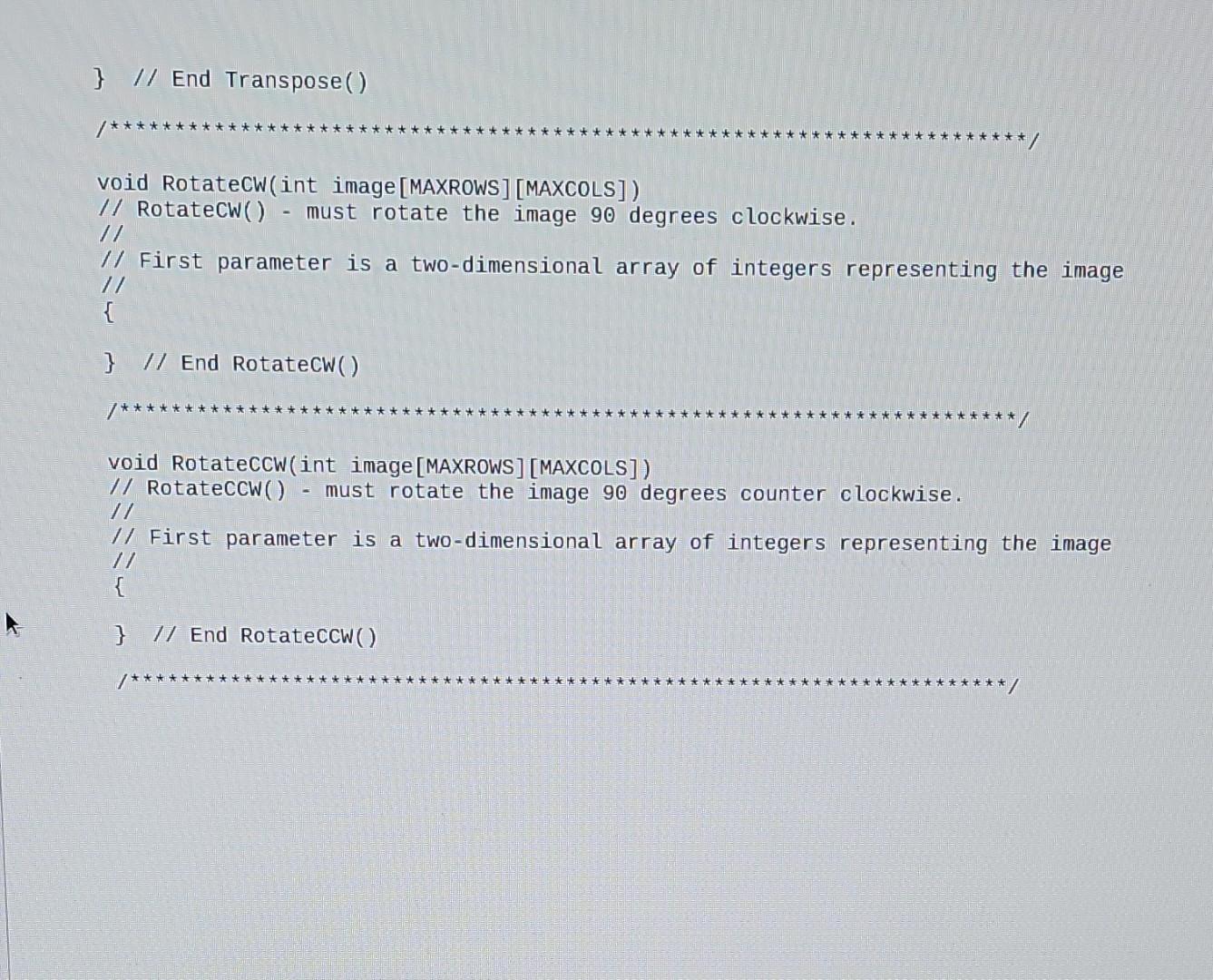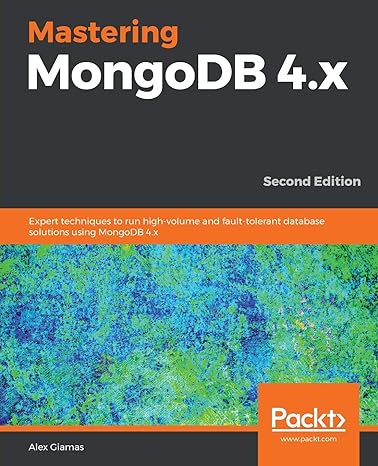Question
A fundamental software engineering skill is the design, implementation, and testing of a software component that may be integrated into a larger software product. In
A fundamental software engineering skill is the design, implementation, and testing of a software component that may be integrated into a larger software product. In order to do this, the software component must conform to a previously agreed upon interface format. As part of this assignment, you will practice this skill by writing several functions that will be integrated into a larger software product provided by the instructor. Along the way you will review basic C++ programming skills required for successful completion of CPE 212.
For this project, you will complete the provided partial C++ program by implementing six functions that perform simple image processing operations on images stored as 10x10, two dimensional arrays of integers. The image processing operations are:
(1) Load Image
(2) Horizontal Flip
(3) Vertical Flip
(4) Transpose
(5) Rotate 90 Clockwise
(6) Rotate 90 Counter Clockwise
You must implement each of these operations as a C++ function. Your code for the six functions above must appear in the file named project01.cpp in order to compile correctly. Remember, spelling and capitalization count in Linux/C++.
The function main() has already been implemented for you to provide a common way for everyone to test their code. The function main() will scan a sample input file and perform the requested series of image processing operations by invoking your functions as needed.
Prototypes for the six functions are already provided for you in main.cpp (do not modify main.cpp !!!). All program output is performed by the code in the main.cpp file do not include any output statements in the file project01.cpp
The interfaces to each of these functions you must write are described in detail on subsequent pages and in the prototypes listed within main.cpp
Hint: Match the output of your program to that of the sample solution!!!
Directions for running the sample solution appear on the following page.
Running the Sample Solution on blackhawk
The best description of what your code should do is the Sample Solution for the project.
Run the sample solution by typing the following at blackhawk terminal window command prompt
/home/work/cpe212/project01/p01 imagefilename
NOTE: You may get a permission denied error running the above line. In that case use this copy of the executable: p01-ref. Copy p01-ref to your working directory and type "./p01-ref p01input1.txt". Try it with all the input files.
where imagefilename is the name of one of the provided input files (for example, p01input1.txt). Your current working directory must contain the input files for this to work.
Unzipping Sample Input Files on blackhawk
Use the secure copy portion of MobaXterm to copy the project01_materials.zip file to the Blackhawk server. Make a project01 directory (this will be your working directory) and move the project01_materials.zip file that working directory (us the "mv" command). Use unzip to expand the project01_materials.zip file.
For example: unzip NameOfZipFileHere
to unzip the files into your current directory.
Since this project is worth five points, you have been given five input files (which utilize the three image files) to test your program.
Running the Preview Script on blackhawk
Run the preview script by typing the following in a blackhawk terminal window command prompt
/home/work/cpe212data/project01/preview01.bash
NOTE: You may get a permission denied error. In that case use this copy of the preview script: preview01.bash. Run this version without arguments to see how to use it.
Usage:
1. Copy preview01.bash to your working directory.
2. Create a directory called "tests".
3. Copy all the p01input#.txt files to the tests directory.
4. Type "./preview01.bash ./project01 . p01input1.txt". Try it with all the input files.
Also, this new version is different than the /home/work/cpe212data/project01/preview01.bash. The latter takes no arguments.
This script will run both the Sample Solution AND your project01 executable program on the complete set of input files, and it compares the outputs of the two programs line by line to identify errors in your program's outputs. Make sure that the output of your program exactly matches the output of the Sample Solution.
This project consists of two C++ files one named main.cpp provided by the instructor and one named project01.cpp written by you, along with a file named makefile to help you compile your program. A makefile contains the sequence of commands required to compile and assemble (link) your executable program. The provided file works on blackhawk. If you examine the structure of main.cpp, you will see an extra #include directive near the end of the file this statement will cause the preprocessor to import the function definitions you have written and saved in the project01.cpp file. So, for this assignment, all you must do to compile the program is to use the following command at the Linux command line
make
which will create an executable named project01 from the provided main.cpp and the project01.cpp file you have written. While this is not a standard use of or location for a #include statement, it will help facilitate automatic grading of your submission.
If your program compiled successfully, you may then type
./project01 NameOfInputFile
to execute your program assuming that the input file is located in the same directory with the executable. (For example, ./project01 p01input1.txt )
Remember, submit only the project01.cpp file for grading.
You will be provided with a C++ file named main.cpp which contains the main() function of the program. The function main() contains code that invokes several supporting functions that you must implement. The support functions you will write must be placed in a file named project01.cpp [lowercase letters, no spaces] in order for your program to compile and execute.
Important directions you must follow:
Do not modify the file named main.cpp!!!
Failure to satisfy this requirement will result in zero credit (0 points) on this assignment.
All of your work (the support functions) must be placed in a file named project01.cpp. All lowercase letters in the filename with no spaces.
Failure to satisfy this requirement will result in zero credit (0 points) on this assignment.
All output to the monitor (stdout) will be performed by the code provided in project01.cpp.
Your program must be fully commented (including variable and parameter declarations, functions, logical blocks) in order to receive debugging assistance from the instructor and teaching assistants.
NOTE: Your project submission will be automatically graded so it is EXTREMELY IMPORTANT that you READ and FOLLOW the project directions.
Submit only project01.cpp to the Canvas assignment.
Submisssions by email receive ZERO CREDIT (0 points)!!!
Submissions that do not compile receive ZERO CREDIT (0 points)!!!
On Project01, you may only use the following include files:
#include
#include
#include
which have already been integrated into the provided file named main.cpp
Failure to follow these directions will result in zero (0) credit on this assignment.
Use the function prototypes appearing in main.cpp to create a file named project01.cpp that contains empty function definitions. Be sure that you can successfully use make to compile this skeleton solution before adding any additional code.
The LoadImage function is critical if this function does not work, then your project will fail every test. Make sure that LoadImage works before continuing with any other functions.
After LoadImage, implement the simplest operations FlipHorizontal, FlipVertical, and Transpose one at a time, testing each with the appropriate input file. Rotations may be implemented by combinations of the three simplest operations.
void LoadImage(const string imagefile, int image[MAXROWS][MAXCOLS]);
// LoadImage() must open the image file for input and load the image into a
// two-dimensional array for subsequent processing. Assume that the file will open.
// Parameter imagefile is a string that will hold the name of the image file to load.
// Parameter image is a two-dimensional array of integers representing the image
// loaded from the file
//
// Note: Correct operation of this function is critical!! If one cannot correctly
// load images into the array from the file, then one cannot test the
// image processing operations and your code will fail every test!
void FlipHorizontal(int image[MAXROWS][MAXCOLS]);
// FlipHorizontal() - must flip the image horizontally. For example,
// column zero exchanged with column N-1, column one exchanged with column N-2, etc.
// Parameter image is a two-dimensional array of integers representing the image
void FlipVertical(int image[MAXROWS][MAXCOLS]);
// FlipVertical() - must flip the image Vertically. For example,
// row zero exchanged with row N-1, row one exchanged with row N-2, etc.
// Parameter image is a two-dimensional array of integers representing the image
void RotateCW(int image[MAXROWS][MAXCOLS]);
// RotateCW() - must rotate the image 90 degrees clockwise.
// Parameter image is a two-dimensional array of integers representing the image
void RotateCCW(int image[MAXROWS][MAXCOLS]);
// RotateCCW() - must rotate the image 90 degrees counter clockwise.
// Parameter image is a two-dimensional array of integers representing the image
void Transpose(int image[MAXROWS][MAXCOLS]);
// Transpose() - must flip the image across the primary diagonal row = column as
// with a matrix transpose
// Parameter image is a two-dimensional array of integers representing the image
The starter file is


Step by Step Solution
There are 3 Steps involved in it
Step: 1

Get Instant Access to Expert-Tailored Solutions
See step-by-step solutions with expert insights and AI powered tools for academic success
Step: 2

Step: 3

Ace Your Homework with AI
Get the answers you need in no time with our AI-driven, step-by-step assistance
Get Started


